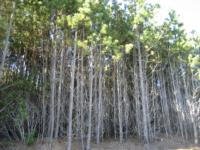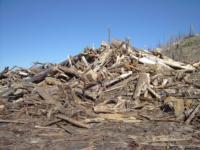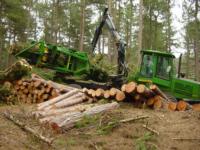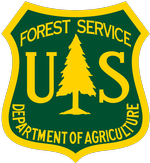About Biomass
Woody biomass is one category within the larger umbrella of biomass, which is defined as any organic plant and animal material as well as products and residues generated from these materials. Woody biomass comprises residues of the wood processing industry, post-consumer woody waste materials and agricultural residues in addition to material arising from forest management or fuels reduction activities.
Forest biomass includes small-diameter woody material, damaged or low-valued trees, the branches and tops (slash) and diseased or insect infested wood. This material represents a huge untapped biomass resource and its removal could improve forest health and reduce the risk of catastrophic wildfire. As of 2019, five percent of total primary energy use in the U.S. (5 quadrillion BTU’s) was provided by biomass – there is potential for this to be much higher. Wood and wood-derived biomass accounted for 46 percent of that energy. In California specifically, 2.92 percent of in-state electricity generation was derived from biomass in 2019.
Historically, from 1990 to 1993 was when California’s biomass power generation was highest at over 800 MW of capacity and 66 operating facilities. This production capacity has continued to dwindle ever since due primarily to the expiration of government price support to the biomass industry in 1996. Some of these facilities were dismantled, but many others are simply idle and offer opportunities for future operation without requiring new construction.
Utilizing Woody Biomass
Much of the forest biomass resource is not currently utilized due to its poor physical properties and therefore relatively low value. The expense of removal and transportation further reduces its appeal as a raw material. Developing more markets and processing technologies to use this material would help to recover some of the cost of ecosystem restoration and fuels reduction projects.
The challenges for using woody biomass are many and the economic opportunities limited. Although there is a long list of products that could be produced from woody biomass there are often competing raw materials to make these products that are of higher quality and lower cost. The solutions to providing more opportunities for woody biomass lie in encouraging their use in efficient energy conversion facilities (power plants, heat and power systems, etc.), using small diameter trees in their round form instead of trying to produce lumber, supporting the research and development needed to encourage investment in higher value fiber uses for composite materials (such as composite panels and wood fiber/plastic products), and continuing the search for cost-effective chemical processing to biofuels and other organic chemicals.



Many detractors from woody biomass argue that it requires clearcutting and that the carbon and byproducts that processing woody biomass releases nullify its status as a green, renewable fuel and electricity source. However, in California we are facing a situation where many areas of our forestlands are severe wildfire hazards due to an accumulation of fuels as a result of fire suppression. Removal of these fuels is critical to preserving our forests and protecting communities. Utilizing woody biomass can be one component in working to treat as many acres of public and private land as possible – without clearcutting or growing trees/plants specifically for bioenergy production. Residues, slash, and non-merchantable timber that is not utilized as biomass but left in the forest will likely be pile or prescribed burned (releasing all carbon and smoke emissions into the atmosphere) or burn in a wildfire and increase the intensity and loss caused by a fire. Removing these fuels to be used as forest biomass enables energy or heat production from wood that otherwise would burn wastefully and release any stored carbon into the atmosphere.
Resources
Visit our other pages for further information about biomass as a resource and how it can be utilized. For more fundamental background information on woody biomass and why it is not only viable but necessary check out this presentation. Use our interactive map to find current facilities and biomass projects in California.
Our collection of publications and infoguides produced by or in association with the Woody Biomass Utilization Group and its collaborators may be found here.



